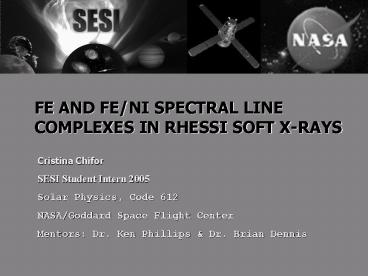LASP Summer Internship 2004 - PowerPoint PPT Presentation
Title:
LASP Summer Internship 2004
Description:
Mentors: Dr. Ken Phillips & Dr. Brian Dennis ... Electron kinetic energy higher than average thermal energy of ... Pint Of Ale. MORE COMPLICATIONS: INSTRUMENTAL ... – PowerPoint PPT presentation
Number of Views:42
Avg rating:3.0/5.0
Title: LASP Summer Internship 2004
1
FE AND FE/NI SPECTRAL LINE COMPLEXES IN RHESSI
SOFT X-RAYS
Cristina Chifor SESI Student Intern 2005 Solar
Physics, Code 612 NASA/Goddard Space Flight
Center Mentors Dr. Ken Phillips Dr. Brian
Dennis
2
SOLAR FLARE X-RAYS
- 2. Thermal
- Depends on the random thermal
- motion of the heated electrons
- Maxwellian distribution of electron velocities
- 1. Non-Thermal
- Synchrotron radiation
- Electron kinetic energy higher than average
thermal energy of plasma
BREMSSTRAHLUNG
ELECTRON PROTON PHOTON
3
REUVEN RAMATY HIGH ENERGY SOLAR SPECTROSCOPIC
IMAGER
- X-ray/gamma-ray spectrometer
- 3 keV 17 MeV
- 9 Ge detectors
- 1 keV resolution
- Images through modulation collimators
- (2 arcsec resolution)
- Movable shutters control high photon fluxes
4
SPECTRAL MODELLING
One spectrum is worth a thousand images. A.
Dupree.
- Thermal component of flare X-rays
- ( 3 keV -20 keV )
- Physical plasma properties T, emission measure,
elemental abundances etc.
5
MAIN PROJECT GOAL
- Analyze the Fe (6.7 keV) and Fe/Ni (8 keV) line
complexes in the soft X-ray part of the solar
flare spectra from RHESSI.
Why bother ?
- Valuable diagnostic information about emitting
plasma (e.g. T dependent) - Can determine the origin of flare plasma (since
coronal Fe abundances 4 x photospheric Fe
abundances) - Better understand the RHESSI transmission as a
function of energy in different attenuator states
and the effects of increased count rates
6
FLARE SAMPLING
Using the Geostationary Operational
Environmental Satellites (GOES).
- Isothermal approximation OK in the late decay
stages - So, hunt for
- long duration, slowly decaying flares
- IDL GUI to make quick plots of monthly GOES
data - Any RHESSI data for the selected times
- (no data gaps, particle precipitation
events, SAA) ?
7
METHOD
- 1. Count rate spectrum file response matrix
file - 20 - 60 s time bins
- 0.3 keV energy bins
- 2. Background subtraction
- Choose model functions to fit 5 15 keV
- Fit model to data
- 1 isothermal component 2 Gaussian lines (1 keV
FWHM) centered at 6.7 and 8 keV - Reduce chi-squared
5. Calculate complexes EQW plot vs. T
In total, this summer gt 2000 spectra for gt 30
flares
8
THE BULK OF RESULTS
http//hesperia.gsfc.nasa.gov/hessi/chifor
9
COMPLICATIONS MULTI-THERMAL FLARE PLASMAS
- Most evident during flare rise, peak, soon after
peak. - Each T component in a multi-thermal plasma
contribute to the fluxes in the Fe and Fe/Ni
complexes - To help with DEM analysis, we had guests this
summer !
- Dr. Janusz Sylwester (Polish Academy of
Sciences) - RESIK (soft X-ray Bragg crystal spectrometer)
- DEM onology
- RESIK vs RHESSI cross-calibrations
- LiWei Lin (Harvard Smithsonian Astrophysical
Observatory) - Pint Of Ale
10
MORE COMPLICATIONS INSTRUMENTAL
- High count rates in RHESSI detectors decrease
energy resolution in the soft X-ray range and
increase calculated T. - Line complexes difficult to detect. Fitting
Gaussians vary in width. - Does this mean that results from lowest count
rates (both sets of shutters in ) are most
reliable ?
http//hesperia.gsfc.nasa.gov/hessi/chifor/may0720
02_html/feqw.htm http//hesperia.gsfc.nasa.gov
/hessi/chifor/nov112003_html/nov112003.htm
11
CONCLUSIONS
- RHESSI instrumental effects are important (e.g.
high count rates decrease energy resolution in
the soft X-ray range). - Multi thermal flare plasma calls for DEM
techniques. - However, ok results where isothermal
approximation appropriate. - Coronal origin of flare plasma (from calculated
Fe abundances). - Fe and Fe/Ni EQWs vs. T follow theoretical
diagnostic curves. - But, there may be a need for improved
theoretical atomic calculations. - RHESSI Observations of the Solar Flare Fe and
Fe/Ni Lines paper to be submitted to the
Astrophysical Journal soon.
12
SPECIAL THANK YOU
Dr. Ken Phillips Dr. Brian Dennis Ana
Rosas Merrick Berg CUA International Office
13
END OF PRESENTATION
14
(No Transcript)
15
Count rate spectral fit in OSPEX
16
RHESSI count flux vs. time
17
SUN RECIPE

